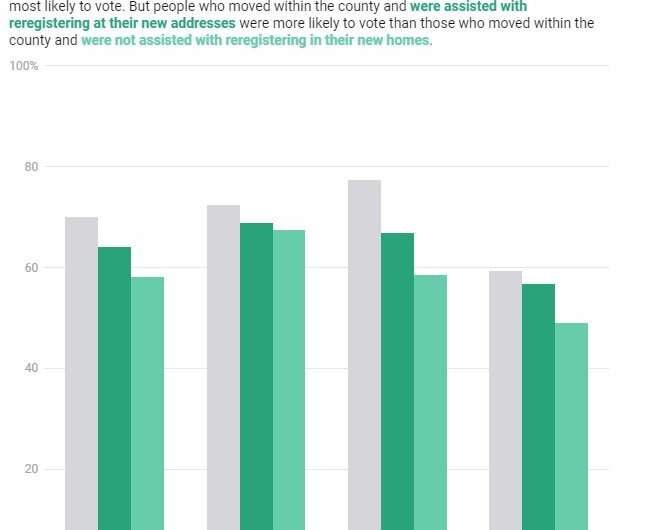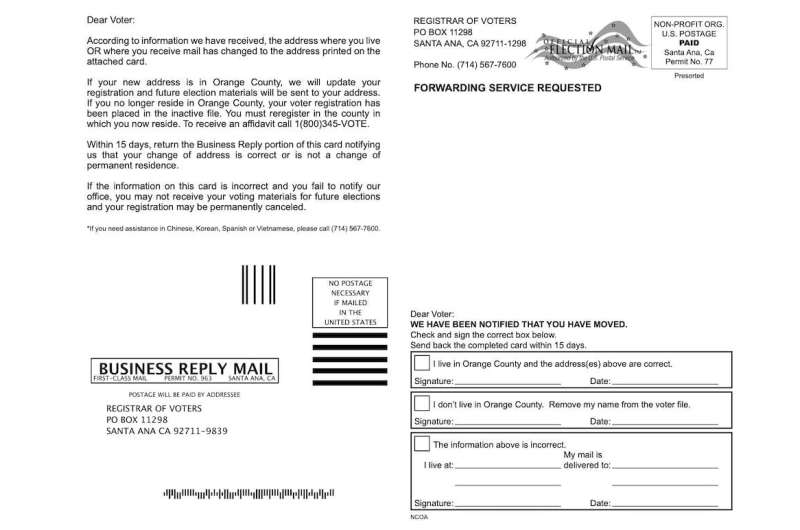Automatic voter reregistration can substantially boost turnout

Government efforts to keep registered voters on the rolls when they move from one address to another substantially boost those voters' likelihood of casting a ballot, my research has found.
It's long been known that the rules about how and when to register to vote—which —present a . In many nations, including Germany, Denmark, South Korea, Chile, Israel and others, citizens are automatically registered to vote when they become eligible to vote. Registration is the government's responsibility.
have called for the U.S. or its states to adopt similar policies, broadly called "automatic voter registration." Indeed, it was a major part of the , a bill introduced in early 2021 to address various aspects of U.S. election systems.
There is an existing federal law, often called the "," that allows people who are getting a driver's license to choose to simultaneously register to vote for federal elections.
Automatic voter registration, by contrast, makes the choice for people, and of voter registration if they wish. In 2016, Oregon became the first state to , eliminating the need for voters to take an extra registration step.
In the meantime, some communities are trying to help registered voters keep their registrations active. For instance, in 2018, election officials in California contacted people who were registered to vote but who had told the U.S. Postal Service they had moved. I evaluated this practice, called automatic reregistration, to see to keep voters actively participating in democratic self-government.
Automatic voter reregistration
Starting in 2015, the state of California began matching voter registration data to data collected by the U.S. Postal Service when people ask to . When someone was detected as having moved within California, the county where they had been registered to vote would send out a postcard to the new address, . Unless they explicitly told the county otherwise, the voter will be automatically reregistered at the new address.

I examined turnout data from Orange County, California, using voters who had moved within the county in June 2018. Voters who moved in the first half of June were automatically reregistered. But those who moved later in the month were not, because they moved too late: A well in advance of a federal election. Apart from the dates of their moves, these two groups of voters were very similar. That allowed me to isolate the effect of automatic reregistration on people's voting habits.
Overall, my analysis found that automatic reregistration boosted voter turnout by over those who were not automatically reregistered.
There were partisan differences. Automatic reregistration had no statistically significant effect on Democrats' turnout but boosted Republican turnout by 8.1 points—and lifted the turnout of people who did not identify with either party by 7.4 points.
Voting access is not just for Democrats
Automatic reregistration is promising because it showed significant effects in a population in which we might expect to have only small effects. These voters had already broken through . In addition, they had moved within Orange County, which meant potentially . Even so, relieving these voters of the reregistration burden effectively boosted turnout.
Voting access has long been a highly partisan issue. Some have even —without much scholarly evidence—that making voting easier could disproportionately benefit Democrats. Indeed, Republicans and Democrats have very different views about easing voting. In a estimate in 2021, only 38% of Republicans supported automatically registering all eligible citizens to vote, while 82% of Democrats supported it.
But in my data, lifting the reregistration burden helped Republicans and independent voters more than Democrats. Of course, the 2018 general election was one in which Democrats in Orange County were already . This might be why there was not a strong increase in turnout for the automatically reregistered Democrats. Another possibility could be that automatic reregistration disproportionately benefits Republicans and nonpartisan voters for some reason.
Whether the results will hold true in other elections and places remains to be seen. Nonetheless, the results show that automatic reregistration was effective in keeping voters actively participating, and they also show that easing voting in this way does not benefit only Democrats.
Provided by The Conversation
This article is republished from under a Creative Commons license. Read the .![]()




















